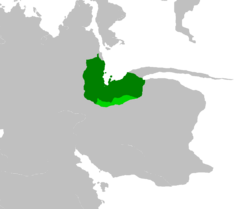Kretaza
This article is incomplete because it is pending further input from participants, or it is a work-in-progress by one author. Please comment on this article's talk page to share your input, comments and questions. Note: To contribute to this article, you may need to seek help from the author(s) of this page. |
The Great Kingdom of Kretaza | |
|---|---|
Banner of the Sejm of Kretaza
| |
 The Location of Kretaza in north-eastern Deteros, with the Cizimenean Confederacy highlighted. | |
| Capital | Kospal |
| Largest city | Deikei |
| Official languages | Katni Nizni Meikean Nizni Fendirolean |
| Ethnic groups |
|
| Religion | Nizni Bowism |
| Demonym(s) | Kretazan |
| Government | Feudal Parliamentary Republic |
| Yulakorszan of Cizimene | |
| Legislature | Sejm of Kretaza |
| Establishment | |
• Proclamation of Kretazan Kingdom | Summer 1033 |
| 1224 | |
• Monarchy abolished | Spring 1372 |
| Area | |
• Total | 829,556 km2 (320,293 sq mi) (6th) |
| Population | |
• 1386 estimate | ~11.2 million (6th) |
• Density | 34.97/km2 (90.6/sq mi) (30th) |
| Currency | Various |
Kretaza, officially the Great Kingdom of Kretaza, is a Nizni-speaking state in north-eastern Deteros. According to traditional Nizni historiography, it is considered the ninth Nizni kingdom. Originally a feudal kingdom ruled jointly by an assembly of nobles, the Sejm, and a king, it came under the full control of the Sejm in 1372. Covering an area of around 830,000 square kilometres, it is the sixth largest polity in the known world, and has an estimated population of 11.2 million.
Kretaza places itself as the ninth Kingdom in a cyclical lineage of successive 'Nizni kingdoms' existing between the Pranem and Kanget rivers, and especially the second century Kingdom of Odenko. It was established in 1033 by an alliance of powerful local landowners around the Zabou estuary during the Lords' Revolt, a rebellion against the perceived oppression and neglect of the ruling Kingdom of Vyaamen. During the revolt, these landowners elected a king to act as a military leader, making decisions in ad-hoc assemblies which would later evolve into the Sejm of Kretaza. After being established as an independent kingdom, Kretaza would steadily expand to occupy a large territory, including the subjugation of the powerful Kingdom of Fendirol. In the early thirteenth century, Kretaza would almost totally collapse, before being restored under a stronger monarchical regime by King Paskol. In 1366, relations between the monarchy of Matos IV and Sejm would deteriorate into a destructive civil war, ending the execution of Matos and end of the Kretazan monarchy in favour of direct rule by the Sejm, under a lord protector.
Kretaza has a largely agrarian economy under a largely feudal system, with a significant population of pastoralists. Forms of land tenure and taxation vary between different regions and constituent groups of the state. Kretaza's most significant export good is wool. Kretaza does not have a centralised administration or legal system, instead having an extensive and variable system of customary law.
History
==
The earliest evidence of complex society in modern-day Kretaza is represented by the megalithic Pranemene dolmens, a large array of dolmens in central Pranemo, thought to have been erected between 3000 and 2000 AE. The builders of the dolmens had domesticated wheat and oats by their construction. The oldest archaeological evidence suggesting the existence of hierarchical society is Lasnos Hryd, the remains of a fort or small walled city in Pranemo, inhabited between c.1400 and c.1200 AE. The relationship between the dolmen-builders, Lasnos Hryd, and Nizni people is unknown, though Lasnos Hryd's period of habitation falls within the accepted lifespan of the mythological first Nizni kingdom, Nesenuna. Linguistic evidence appears to suggest that proto-Nizni speakers did not inhabit Pranemo until the 1st millennium AE.
The first Nizni kingdom known to have had a historical basis is the third, Stavostani. Lasting between 401 and 259 AE, it was a small regional polity on the northern bank of the Zabou estuary. Nizni logograms were first used in Stavostani, and are thought to have been developed independently without the influence of other writing systems. The names and reigns of kings form most of what is known about the history of Stavostani, though an extensive mythologised history has developed since. In 259, a long civil war resulted in the creation of a new kingdom, Rajiba. During its existence, Rajiba expanded to the southern bank of the Zabou estuary, establishing control over the entirity of the lower Zabou. Ruled from the walled city of Sazicile, the kingdom came into repeated conflicts with the First Iteran Kingdom. In 4 IE, Rajiba experienced a war of succession, culminating in its total collapse, ending political unity in the lower Zabou for over a century.
In 112 IE, a charismatic noble leader named Atelikol founded a new kingdom in the uplands adjacent to the eastern lower Zabou. Named Odenko, Atelikol's kingdom soon came to encompass the entirity of the lower Zabou region. Atelikol established a patrimonial system of administration in Odenko, creating a three-rank nobility requiring generational renewal by the king, and constructed a royal ideology in which the monarch acted as chosen patron of the tienavu (gods); particularly Slikonekon, a personification of the harvest. Atelikol I's successor, Olikit I, expanded the lands of Odenko dramatically by invading and conquering the large, sparsely populated region of Pranemo, as well as much of the upper Zabou. This expansion would continue under his successors, until the long-lived fourth king of Odenko Atkol I stabilised the kingdom's territories at the Southern Mountains, river Pranem, and river Kanget. At Oranod, within the original lands of Odenko, Atkol would construct for himself a vast, circular monumental tomb, the first of several monumental tombs created by Odenkine kings. Under Odenkine rule, lasting until 458 IE, a literary culture developed in the lower Zabou, beginning the Nizni literary tradition. A distinction was also increasingly established between a Nizni (proper) civilisation centred in the lower Zabou, and surrounding lands, characterised as barbaric.
The weakening and collapse of Odenko in the 5th century IE created a series of Nizni regional polities with similar elite cultures across a large area, with the kingdom of Odenko ceasing to exist in 458. Between 516 and 530, most of these were reunited by Zaclan Ovosiel, a skilled military commander who established a new Odenkine kingdom under a puppet king, creating the largest Nizni state in history. After Zaclan Ovosiel's death, his son and successor Zaclan Nesiny deposed the Odenkine ruler in favour of himself, establishing the kingdom of Zlacanamo, a name which would also be used for Zaclan Ovosiel's state in later histories. In 520, Zaclan Nesiny would be deposed by the Pranemene noble Sikin Belit, precipitating a civil war. Sikin, forced to relinquish large portions of Zlacanamo's territory, distanced himself from the state by proclaiming the kingdom of Mezikami.
Mezikami, which ruled an area slightly smaller than Odenko, presided over increasing inter-regional trade and economic fortunes, as well as significant population growth on the lower Zabou, as well as Semisto. To legitimise the overthrow of Zlacanamo and non-re-enthronement of the Odenkine royal family, the notion of successive Nizni, or civilised kingdoms, cyclically repeating into the distant past, was established, and would be promoted strongly by historical works sponsored by Mezikamine monarchs. After a series of intense wars, the sixth king of Mezikami Sikin III conquered the Second Iteran Kingdom in 616, imposing a Nizni-speaking elite on the region which would begin the decline of Iteran as a literary language.
